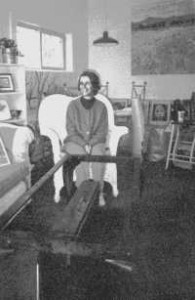Column by George Sibley
Climate – December 2000 – Colorado Central Magazine
IT’S SNOWING THIS MORNING — not real hard here in Gunnison, but I can guess what it’s doing upvalley, in Crested Butte or up on Monarch Pass.
It snowed all day in Crested Butte yesterday, and having lived there once, I can remember what that was like — going to bed with visions of powder plumes dancing in my wee spinning head. Spinning because when it really snows in a mountain town, you usually find yourself hanging out in a bar with everyone else that’s snowstruck, just watching it come down.
We don’t as a rule get blizzards in the mountains; when the weather gets serious here, what we get is “dumps.” Big fat pregnant clouds bump up against the slopes like wind-driven water balloons, break over the ridges, and — dump. Soft thick snow comes straight down with an intensity that all but excludes space for sound, breath, anything.
A week of snow like that, and it starts to take over the life of the towns that we’ve planted up in the snow zone. You spend increasing amounts of time just moving snow around. I remember waking up to creaking sounds one night in Crested Butte, and realizing that it was time for us to shovel the snow off the roof (or else). When we got down off that roof about daybreak — the soft thick snowfall barely let the light through — we went inside to discover that what we’d pushed off the roof had piled up against a living room window and broken through; so then we had to shovel snow out of the living room.
Then it stops — or at least it has always stopped recently — but you can look up at the great carved bowls in the mountains and think of the times when it didn’t stop snowing. In those times, snow compacted to ice and lay a thousand feet thick where the town is now. The first day of a mountain storm, it’s hard to put them together: this soft feathery stuff falling down without a sound, and a force so heavy and abrasive that it gouges great cirques out of solid rock. By the third or fourth day, though, when you’re shoveling to find your car — because it has to be moved to the other side of the street by nightfall — you can start to believe in glaciers.
Last night, I was reading an article about global warming, and this morning, I can’t separate these thoughts of snow from thoughts of manmade climate change. Mainly, I think — Why not? Why don’t we do everything we can to induce a little global warming? There’s no reason, after all, to believe that the Ice Age is gone. Scientists now think that, over the past two million years, the big ice has advanced and retreated as many as 20 times, with some interglacials longer and warmer than this current retreat that we call the Holocene. Everything science has discovered about the Ice Age confirms the dour intuition of New England farmers: “The glaciers aren’t gone; they just went back for more rocks.”
So why not just go ahead full bore and do what we can to turn the whole earth into a big round greenhouse that’s too warm for the Big Ice? All that fossilized carbon we’re mining out of the earth was up on the surface once — in the carbon cycle, plant material decomposing to atmospheric carbon dioxide and back to plant material.
And the earth was a real greenhouse then, back in the Paleozoic. Big steamy swamps were too prolifically out of balance to decay fast enough — thus the big carbon banks we mine today. So let’s raise as much of that banked carbon back up to the surface as we can, get it back in the cycle as atmospheric carbon dioxide — and warm this place up for good!
THIS WARM-BLOODED REASONING, of course, is wrong. Temperature records associated with past glaciations indicate that the cyclic warming of the global climate that melts the Big Ice — probably related to wobbles in the earth’s rotation around the sun — may also be what eventually tips the planet back toward the Big Ice.
As the polar ice caps melt, they dump cold fresh water into the North Atlantic, which weakens the big warm salt-water currents in the ocean that mellow the climates of the northern latitudes. Thus the weather over northern Europe and North America gets more intemperate, with subtle shifts in the balance of ice time versus melt time; and the glaciers start to grow again. So our all-out efforts to pump up the temperature may not push back the next glaciation (as other scientists believe); it may speed it up.
So…
Think of a carbon-based Pleistocene man in the time of the sun’s retreat. Regardless, I’ll still head up toward Pitkin on the winter solstice, to the Coleman’s bonfire party, to watch the hot sparks contend against the great cold vacuum of the night. A merry solstice to all.
George Sibley used to own the newspaper in Crested Butte, and now writes and teaches in Gunnison.

